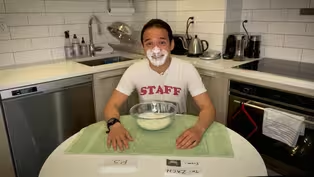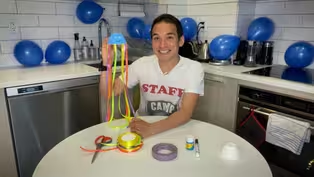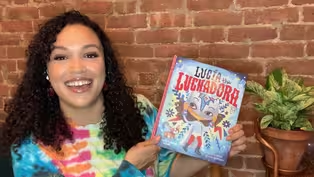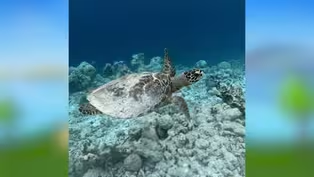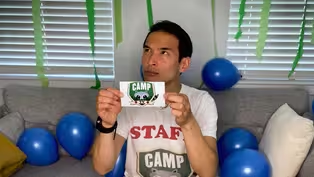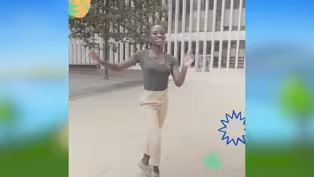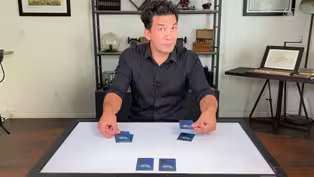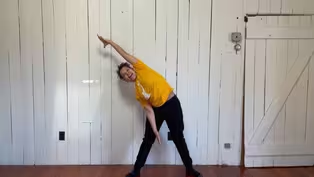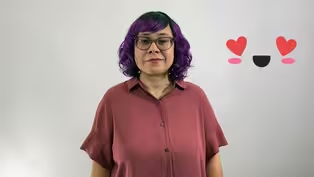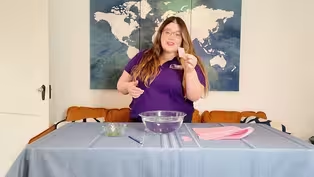
Ocean Day (Long Version)
7/7/2021 | 56m 46sVideo has Closed Captions
Learn about sharks, sketch in the sand, make jellyfish, play a sea animal guessing game!
Join head counselor Zach to learn about sharks, sketch in the sand, make jellyfish, play guess the sea animal! Learn a card trick, dance samba. Content partners include One Voice Children’s Choir, Impossible Science, Liberty Science Center, Lincoln Center, Monterey Bay Aquarium, National Dance Institute, NY Philharmonic, Sketch with Jeff at the Guggenheim Museum, They Might Be Giants.
Problems playing video? | Closed Captioning Feedback
Problems playing video? | Closed Captioning Feedback
Camp TV is a local public television program presented by THIRTEEN PBS

Ocean Day (Long Version)
7/7/2021 | 56m 46sVideo has Closed Captions
Join head counselor Zach to learn about sharks, sketch in the sand, make jellyfish, play guess the sea animal! Learn a card trick, dance samba. Content partners include One Voice Children’s Choir, Impossible Science, Liberty Science Center, Lincoln Center, Monterey Bay Aquarium, National Dance Institute, NY Philharmonic, Sketch with Jeff at the Guggenheim Museum, They Might Be Giants.
Problems playing video? | Closed Captioning Feedback
How to Watch Camp TV
Camp TV is available to stream on pbs.org and the free PBS App, available on iPhone, Apple TV, Android TV, Android smartphones, Amazon Fire TV, Amazon Fire Tablet, Roku, Samsung Smart TV, and Vizio.
Providing Support for PBS.org
Learn Moreabout PBS online sponsorship- Hi everybody.
My name is Zach, and welcome to Camp TV.
Are you ready for some summer fun?
Me too.
Now as your head counselor, I will be introducing you to all sorts of cool activities: arts, crafts, games, math and science, as well as some of my favorite books, nature and theater.
I will be here to take you from one activity to the next.
So follow me on Camp TV.
[upbeat music] - [Narrator] This program was made possible in part by the Corporation for Public Broadcasting, a private corporation funded by the American people.
Additional funding was provided by the Peter G. Peterson and Joan Ganz Cooney Fund, and the Pine Tree Foundation of New York.
[lively music] ♪ Camp TV ♪ ♪ It's time for us to start ♪ ♪ From furry animal encounters ♪ ♪ To some reading and the arts ♪ ♪ No matter what the weather ♪ ♪ We'll throw it all together ♪ ♪ It's a place for you and me ♪ ♪ It's Camp TV ♪ [indistinct] - Whoops.
Let's try that again.
Hi, welcome to Camp TV.
I was just about to take a dip in the ocean.
[inhales] I just love that smell.
I also love swimming in it, snorkeling in it and boogie boarding in it.
It's like a liquid playground.
And when I'm tired, it's the best to just sit back, relax and enjoy listening to those crashing waves.
I guess you could say I pretty much love everything about the ocean.
And when you look below the surface, you realize it's one of nature's great superheroes.
The ocean helps regulate weather, is home to hundreds of thousands of amazing species, and its plants provide over half the oxygen we breathe.
Our health and the ocean's health are connected.
And it's up to us to preserve and protect it.
So, I say it's high time we celebrate the ocean.
Welcome to Ocean Day on Camp TV.
I'm off for a dip.
Have a whale of a good time at your first activity.
- [Narrator] Music, dance, magic and more.
Step right up to center stage.
[gentle music] ♪ I've been reading books of old ♪ ♪ The legends and the myths ♪ ♪ Achilles and his gold ♪ ♪ Hercules and his gifts ♪ ♪ Spider-Man's control ♪ ♪ And Batman with his fists ♪ ♪ And clearly I don't see myself upon that list ♪ ♪ But she said, where'd you wanna go ♪ ♪ How much you wanna risk ♪ ♪ I'm not looking for somebody ♪ ♪ With some superhuman gifts ♪ ♪ Some superhero ♪ ♪ Some fairy-tale bliss ♪ ♪ Just something I can turn to ♪ ♪ Somebody I can kiss ♪ ♪ I want something just like this ♪ ♪ Doo-doo-doo, doo-doo-doo ♪ ♪ Doo-doo-doo, doo-doo ♪ ♪ Doo-doo-doo, doo-doo-doo ♪ ♪ I've been reading books of old ♪ ♪ The legends and the myths ♪ ♪ The testaments they told ♪ ♪ The moon and its eclipse ♪ ♪ And Superman unrolls ♪ ♪ A suit before he lifts ♪ ♪ But I'm not the kind of person that it fits ♪ ♪ But she said, where'd you wanna go ♪ ♪ How much you wanna risk ♪ ♪ I'm not lookin' for somebody ♪ ♪ With some superhuman gifts ♪ ♪ Some superhero ♪ ♪ Some fairy-tale bliss ♪ ♪ Just something I can turn to ♪ ♪ Somebody I can miss ♪ ♪ I want something just like this ♪ ♪ I want something just like this ♪ ♪ Doo-doo-doo, doo-doo-doo ♪ ♪ Doo-doo-doo, doo-doo ♪ ♪ Doo-doo-doo, doo-doo-doo ♪ ♪ I want something just like this ♪ ♪ Oh-Oh-Oh-Oh ♪ ♪ Oh-Oh-Oh-Oh ♪ ♪ Just, just ♪ ♪ I want something just like this ♪ ♪ Doo-doo-doo, doo-doo-doo ♪ ♪ Doo-doo-doo, doo-doo ♪ ♪ Doo-doo-doo, doo-doo-doo ♪ ♪ I want something just like this ♪ - [Narrator] A little birdie told me, it's time to go wild.
[water burbling] Jump, dance, play, it's time to get active.
Let's move.
- Hi, I'm Jessi, I'm an NDI Teaching Artist.
Today, we're gonna do a move and groove follow along with me and our accompanist, Lee.
Thanks Lee.
Here we go.
All you have to do is follow me.
So start with your feet together and your hands at your side.
Stand so tall.
Let's begin.
[gentle music] Start with a deep breath, [inhales] blow it out.
Bend your knees.
And stretch.
Bend your knees.
And stretch.
Now make a big X.
Make a little o.
Big X.
Little O.
Big X.
Little O.
This time big X, and lower the arms.
Pull the shoulders back.
And forward.
And bend the knees.
A little bounce.
Hands and shoulders almost back.
And forward.
Tap your foot.
Shake your hands.
Shake two hands.
Under the fence.
Other way, tap your foot.
Shake your hand.
Two hands.
Under the fence.
Keep going under the fence.
Pop.
Now march.
March tiny.
March really big.
And tiny.
Little bounce.
Feet apart.
Hopscotch.
Feet together.
Feet apart.
Hopscotch.
Now look side to side.
Look down and up.
Ear to shoulder.
Chin forward back.
Circle the head all the way around.
Add shoulders.
Reverse, head.
Add the shoulders.
Nice, bounce low.
Raise the roof.
One side.
Other side.
Get low.
Raise the roof.
Bounce one side.
Two counts, low, raise the roof, one side, other side.
Low, raise the roof, one side, other side.
Two more like this.
Can you do it in one count?
One.
Whooh.
Reach up, don't stop.
Shake your head.
Shake your shoulders.
Shake you hips.
Everything shakes.
Here comes a big stretch.
And bounce.
Other way, big stretch.
And bounce.
Cut it in half, here we go.
Stretch and bounce.
Stretch and bounce.
Go for a little jog.
And freeze.
Jog, and freeze.
Two more like this.
Again.
Can you do it in three counts?
One, two, three.
One, two, three.
One, two, three.
Now do it in a circle.
Whoa.
What?
Whoa.
Here we go, feet together.
Then balance.
Hand to knee.
To head.
Reach up.
Hug it in.
Put it down.
Let's try the other stye, arms out.
Knee comes up.
Hands to hips.
Head.
Reach up.
Little wave down.
Put it down.
Deep breathe up.
Trickle down.
Two more like this.
Stand tall.
Now make any tall shape that you like, any pose that feels good.
Did you find it?
Now, make any low shape that you like.
Did you find one?
Last thing, find any medium shape, and freeze right there.
Well done friends, stand tall.
That's move and groove for today, see you next time.
- Curiosity and wonder, let's discover together, it's science, wow!
- Hi, my name is Jen, from Liberty Science Center.
And I was just thinking about what happens to different objects when we place them in water.
Have you ever noticed that some objects like our water bottle float, but others like this rock sink?
Now, what do you think would happen to a paperclip?
Do you predict that a paperclip would sink or float?
Let's try it.
Ready?
It sinks.
But guess what?
There's a way we can make it float, and it's not magic, it's science.
To make it happen, we'll need a bowl filled with water, a pencil with an eraser, a dry paperclip, some dishwashing liquid, and some tissue paper squares.
Now, for the squares, don't worry too much about the size.
You just wanna make sure that they're bigger than your paperclip, and that they're small enough to fit inside your bowl of water.
Okay.
So the first step is to take your tissue paper square, and just place it on top of your water so that it floats.
Now you wanna take your dry paperclip and super gently just lay it on top of the tissue paper.
Now, take your eraser and just press those edges of the tissue paper down super carefully until it starts coming away from the paperclip.
And voila!, we've got a floating paperclip.
Now to make our paperclips sink again, we just have to pour a couple of drops of dishwashing liquid into our bowl.
And watch.
Right back to sinking.
So how is this possible?
By using what scientists call, surface tension.
Water is made of molecules that stick together.
Now these sticky molecules create a sort of skin on water's top layer.
By placing our paperclip, first on top of our tissue paper, we were able to lower it into the water without breaking the skin, without breaking the surface tension.
Now, adding our few drops of dishwashing liquid does break the surface tension, which means our paperclip sinks back down.
I'm gonna get ready to do our experiment again.
But this time, instead of water, I'm gonna use milk.
I encourage you to experiment with different liquids as well if you'd like.
Well, thanks for joining me, scientists.
Bye for now.
- Hi and welcome back to Ocean Day on Camp TV.
These are some of my favorite shells that I've collected over the years.
Wanna see?
[phone ringing] Hello.
[seashell gibbering] This is Sea?
[seashell gibbering] Oh, hi.
[seashell gibbering] Yes.
Yes, okay.
[seashell gibbering] Thanks.
[seashell gibbering] Apparently it's time for a Zach challenge.
[upbeat music] what?
Good day to you, Mr. Zach.
Below please find a bowl with gumballs covered in whipped cream.
You will have 20 seconds to plunge your face into this bowl, fish out some gum and blow a bubble.
If you do all this before your time is up, you win, if you don't, I win.
Don't blow it.
Love, Mr. Blowfish, AKA Mr. Pufferfish.
PS, I detect some hesitancy.
You say you love the ocean, respect all marine life, but just how committed are you really?
Guess there's a first for everything.
Okay.
[beep] Here goes nothing.
[beep] [dramatic music] Ooh, man, so close.
[Zach sighs] Well, that was messy.
I'm gonna go get cleaned up.
See you after your next few activities.
[chuckles] [upbeat music] - [Narrator] Arts and crafts?
Yes, please.
Let's get artsy.
[water burbling] - Oh, hi.
Welcome to Sketch with Jeff.
I'm Jeff, as always, I'm really excited to see you.
Today, I'm thinking about water.
Why?
Well, I have many great memories of water, especially during the summer.
I love splashing in water, I love swimming and water.
I even love going on imaginary swims, with my animated friends.
Ooh, this is fun.
Hello turtle.
It's amazing when you think about how many creatures, animals and fish live in the water.
Everything from frogs to of course, many many different types of fish, to turtles.
All of these creatures call water their home.
Bye-bye turtle.
Thinking about water, reminds me of this drawing that I really love from the Guggenheim Museum.
This is a drawing by the artist Paul Clay.
And what I love about it is that, with just a few different marks with his ink pen, he's able to show us that this is a body of water surrounded by hills, mountains, nature.
Look at the lines in the water and the lines that make up the reflections.
Wow, it's really inspiring.
You may know that the Guggenheim Museum is located in Manhattan, a part of New York City where there are a lot of really tall skyscrapers.
But what you may not know, is that the Guggenheim and Manhattan are just a short drive or train ride away from so really great beaches.
Hmm, I wonder what it would be like to be on a beach right now.
- Wow, I didn't know that would happen that fast.
This is amazing.
And really, I'm not far from the Guggenheim, Manhattan or New York City.
Look at this beautiful ocean.
I wonder what kind of drawing we can do at the beach.
I love digging in the sand, using a shovel or using my hands to make lines or just to dig holes.
But it reminds me of the way we draw.
Sometimes we make marks on paper and that seems very similar to the way we might make marks in the sand.
I wonder, [indistinct] drawing.
I can make the same kinds of lines and marks that I might make on paper, but I can do it in the sand, actually using my pencil and just scratching in.
I can also use my fingers to make holes especially if the sand is soft.
And then, once you know it, nature has its own eraser.
[waves raging] I almost feel like are making a drawing every time they roll in and out or the same.
They're taking sand with them, and they're making marks.
And then they're taking sand and leaving it in other places.
Sometimes those marks are lines or bumps.
I wonder what Pencil would think of this.
Pencil do you like the beach?
- Oh, there you are, Pencil.
What are you doing?
Oh, you're making a drawing in the sand.
I love it.
What a nice smile.
I guess you really do like being at the beach.
- I love drawing lines in the sand.
I love the beach and the ocean.
- Wonderful.
Thanks pencil.
I'll see you soon.
I think I'm going to try to make a good drawing in the sand.
Oop, well, there it is.
Oh no, a wave.
I'll start again.
This time actually going to draw a big fish.
It'll look like this.
I'm gonna start with the fish shape.
Notice how the tail gets wider at the back of the fish, and it's rounded in the front.
I'm gonna add a smile, cause it's gonna be a friendly fish.
And make sure that I have an eye.
I'm gonna have the eye looking back at the tail.
I need to have an eyebrow.
Fish don't really have eyebrows, but in this case it will.
It'll also have a fin, and little lines on the fin and the tail.
And then of course I need scales.
The scales are what really show us that it's a fish.
Maybe he should be blowing bubbles too.
There we go.
I'm gonna try to draw this image in the sand.
Come on, let's try it.
[waves raging] You can see I'm drawing the shape of the fish.
I'm using my pencil to draw and dig right into the sand.
I've got that tail shape, and then I've got the curve all the way up the back and around towards the front.
I'm gonna add the eye, a little circle, digging into the sand.
And then when I draw the eyebrow, I might even use my fingers and dig out, and make sure that hole is a little bit deeper.
I also need to remember, of course, that I'm gonna be adding the mouth.
Here's the fish's smile, it's looking like he's very friendly.
And now I wanna add the fin at the top, pushing those little lines.
Looking great, almost like our drawing.
We need to fix that, yeah, need's to be more rounded like I had in my drawing.
Oh-oh, nature's eraser, the waves taking away a bit of my tail.
I wonder how long my fish is gonna last.
Let me give an eyebrow, and then I'm going to fix some of those lines in the tail.
I don't know, this drawing may not be here in a little while.
[waves raging] There's my little fish.
He's not really supposed to last.
I know that he's going to be erased by the waves.
And I've been thinking about, so I've been thinking about the beach and the waves and the ocean, and how they really are making marks and changing and erasing the marks every time the waves come in.
It's a really, really amazing thing.
All right.
Time to go back to our studio and think about drawing.
But now I'm thinking about drawing in a whole new way.
That's really exciting.
Wow.
What a great day at the beach.
I really love drawing with you.
My challenge for this week, for you, is to make a drawing using unusual materials.
Could you make a drawing using a stick in the sand or the dirt?
I can't wait to see what you create.
And in the meantime, I'm going to dream about the beach.
And while I'm thinking about those waves, I'm gonna wave to you, goodbye.
See you soon.
[waves raging] [water burbling] [upbeat music] - Well, that last act challenge was really something.
I'm going to steer clear from answering seashells, and talking with puffer blow fish for a long time.
But, in the meantime, I thought we could play a game called what am I?
It goes like this.
I will describe a sea animal to you, and you have to guess what it is.
Ready to give it a whirl?
Okay, here we go.
My body is made of thin skin, I swim while sitting up straight, and I am the horse of the ocean.
What am I?
Thin skin, swims upright and is the horse of the ocean.
Did you guess it?
If you set a sea horse, you are right.
Oh, I love seahorses.
This tiny fish gets its name from the shape of its head.
See how it looks like a horse?
But that is where the similarities end.
Sea horses propel themselves by using a small thin on their backs that can flutter up to 35 times per second.
They prefer to swim in pairs, with their tails linked together.
And it's the male, not female, who gives birth to babies.
So cool.
Okay, ready for another?
I promise I'm a fish, even though I looked like a snake.
I have gills, very sharp teeth, and sometimes I can be electric.
What am I?
The answer is an eel.
In the case of an electric eel, it can discharge electricity that's stronger than 500 volts.
Ouch.
They use this nifty move against its predators and to catch its prey.
Man, I do not want to mess with these guys.
Okay, shall we dive into another?
I am the largest mammal living in the ocean, but still need air to breathe.
I have a very loud call, and despite my huge size, I love to eat tiny shrimp.
What am I?
I am a whale.
[bell dings] Whales are mammals who breathe air into their lungs.
Blow holes, act like as humans nostrils, but in their case, they're located on the top or back of its head.
Blow holes are covered by muscular flats that keep water from entering them when the whale is underwater.
Pretty crafty.
There are lots of different types of whales.
One of my favorites being the blue wave.
It can grow to 90 or more feet, and weigh as much as 24 elephants.
That is a lot of elephants.
Wowza, so many incredible wonders of the sea, and so many more to discover.
See you after your next few activities.
[upbeat music] Ready for some math that counts?
Count on.
Hey guys, it's Jason Latimer, the world champion of magic, coming to you directly from my home.
And I'm about to show you how to predict the future.
That's right.
When you learn this card trick, you're gonna be able to fool your friends, your family and even your math teachers on this one.
[upbeat music] I've done this trick about a thousand times to myself, because it is so funny, because it just looks like it shouldn't work at all.
So, grab a deck of cards and let's get started.
Now, I'm gonna show you a move to make.
This is our move or what we could call our shuffle.
Take a card from the top, and you're gonna place it on the bottom.
That's it.
Just, you can't take two, you can't take three, it definitely has to be one card from the top to the bottom.
So when I say, make a move or make a shuffle, it's really just one card to the bottom.
That's it, that's all you have to know.
The other thing is, we're gonna be spelling out words.
And for every letter, we're gonna make a move.
So as we spell out the word, every letter requires one card from the top to the bottom.
Now, you're gonna be making choices.
You get to pick which pile you pick up for each letter.
But, for every letter, one card moves from the top to the bottom.
We're gonna need eight cards.
Grab four cards from let's say the hearts, that'll be easy for you guys to follow along with that.
And I'm gonna use four cards from the diamonds.
So, four, three, two, ace on one side.
Put them in descending order, so that the four will be on top and I flip them over.
And ace, two, three, four on the other side, so that the ace is on top in the other pile.
Now, when you do this effect to your friends and family, they don't need to see the setup.
In fact, you could just say I'm making a prediction of how this is gonna work.
Now, today's secret magical words.
It's math or magic.
That's right, math or magic, all of them together.
And we're gonna spell them out, and you get to pick up which pile you want for each letter.
So, you don't have to follow my lead on this, just every time you spell a new letter, flip one card from the tops.
So let's get started.
M-A-T-H. O-R. M-A-G-I-C. All right.
Now, I put the piles down, I'm gonna take the top card from each pile.
I'm gonna place it at the top, right here, just away from them.
So now we only have three cards on each side.
So let's spell math or magic again.
So, here we go.
M-A-T-H. You can do it in any order you want.
O-R. M-A-G-I-C. All right.
Now, take the top card from each pile, set them aside together.
Now, we have two cards on each side, so one last time, let's do it.
M-A-T-H O-R M-A-G-I-C. Top cards placed together.
Now, we could do it again, but we only have one card each.
So let's just slide those together.
Now, you could have made any choice you wanted.
You could have grabbed this pile or that pile, and you could have spell it out any way you chose.
But if you look closely, take a look at these two cards.
How amazing is that those two cards matched up?
And if we take a close look at these two, they matched up.
And the next two, they matched up.
And the last ones, they matched up.
That is unbelievable.
You could have done any choice left or right, and yet you predicted the future by setting up the cards that way.
And if you wanna understand how this is done, I'll give you a hint, it's mathematics.
And it was created by a mathematical wizard slash mathematician slash genius Martin Gardner.
And until next, time stay curious, because the right question changes everything.
- [Narrator] Music, dance, magic and more.
Step right up to center stage.
- Hi, my name is Angelica Negron, and I'm a Composer, and a Teaching Artists at the New York Philharmonic.
Today, we're going to explore musical changes and transitions.
A change is a transformation from one thing to another.
Ice can melt and change into water.
In the different seasons, leaves change colors, and the weather changes too.
Even our feelings are constantly changing.
In music, there are often changes and different sections in the same piece of music.
Composers use transitions to move from one thing to another.
Let's explore different ways of getting from one place to another.
To go from point A to point B, I could start walking faster and faster.
I can walk slower and slower.
Or, I could also do a sudden jump to the next section with no transition.
Or, I could build tension, and then release it.
Can you imagine what these four transitions from point A to point B would sound like in music?
Here's how I imagine the first one would sound like.
[lively music] Here's how I imagine the second one sounds like.
[lively music] And this is how I hear the third one.
[lively music] How do you think the last one would sound?
There are many ways to transition from one idea to the next one.
Can you think of other ways of doing this?
What would those sound like?
Now it's your turn to explore different transitions in your music.
See you next time.
[upbeat music] - [Narrator] A little birdie told me, it's time to go wild.
- Welcome.
My name's Athena, and I'm an Educator here at the Monterey Bay Aquarium.
Often, when people think about the aquarium, they think about sharks.
When you think about sharks, what do you imagine?
I wanna invite you to close your eyes, and imagine a shark.
Is it big or small?
What does it remind you of?
What color is it?
Open your eyes.
Did you imagine this shark?
This is a whale shark, the largest of the known sharks who eat the smallest organisms called plankton.
How about this little shark?
This is a California horn shark pap.
These species only grow to be about three feet long, which is probably shorter than you.
I bet some of you imagined this shark.
This is a great white shark.
The scary stories that we sometimes hear about white sharks from movies, books and television, may not be the real story.
And this leads people to thinking, all sharks are dangerous.
But the truth is quite different.
Let's find out more about these incredible animals.
[bright music] Sharks are part of a group called elasmobranchs.
Some elasmobranchs like skates and rays have flatter bodies than what we typically see in sharks.
There are over 500 types of sharks, rays and skates out in the wild.
And here at the aquarium, we have about 15 different types of elasmobranchs.
Variation in the types of sharks, rays and skates is often dependent on the habitat in which you find them.
For example, pelagic rays, which means rays that live in open ocean, are well-suited to that open sea environment.
Sharks, skates and rays all share specific adaptations.
Let's think about what an adaptation is.
When we talk about adaptations, we're talking about specific body parts and behaviors that an animal has that make it really good at living in a specific habitat.
What do sharks, skates and rays all have in common?
These animals all have special skeletons that are lighter than bone.
So, what do you think sharks and other elasmobranchs skeletons are even made of?
Here's a hint, wiggle your nose and ears, and shout it out.
That's right, cartilage.
One of the super interesting things about the body of a ray, is how they use their flexible fins to help find food.
They kind of look like wings.
Rays will flap their fins in sand in order to expose buried prey, like clams.
When they find that prey, they'll swim over it and slip it up into their mouth.
That ray teeth, are fused into plates that can crush the strongest clamshells.
The rays crushed the entire clam, or other shellfish inside their mouth, spit out the shells, and then eat the soft fleshy parts.
Sharks, skates and rays are mostly all meat eaters or carnivores.
Shark jaws are really well-designed for being predators.
If a tooth breaks or wears out, a new one replaces it.
Rays also grow new teeth continuously, just like sharks do.
Another adaptation you may have noticed on some sharks, like this sevengill, is that they appear to be darker on the top and lighter on the bottom.
If you take a look at this hammerhead shark, you'll also notice a darker appearance on top, and a lighter belly below.
This is a special adaptation that is visible on sharks, rays and skates.
Why do you think some sharks are darker on top and lighter down below?
If you said camouflage, you're right.
Animals down below that look up, might not see them with the sunlight shining down.
And animals above looking down, see dark colors that look like ocean floor.
This specific adaptation is called countershading.
That's right, countershading.
Other animals in the ocean have this adaptation as well.
[upbeat music] How do sharks, skates and rays breathe underwater?
They have gill slits, which means they have more than one opening to their gills.
What else do sharks, skates and rays all have in common?
They have special scales called dermal denticles.
Dermal meaning skin and denticles meaning teeth.
So, skin teeth.
Now that we know sharks, skates and rays, all share these characteristics, do you know if they are fish?
Think about all the adaptations we just talked about.
If you think a shark is a fish, you're right.
We just saw some evidence that sharks, skates and rays have fins, gills and special scales that make them fish.
If you thought, no, maybe you were thinking of that cartilage.
That is the biggest difference between sharks and other fish in the ocean.
This group of sharks, skates and rays are considered cartilaginous fish.
[upbeat music] What do you think would happen if there were no sharks, skates and rays in the ocean?
If you were thinking unbalanced, that's a great way to think about it.
We know that elasmobranchs play an important role in ocean food webs.
So, many of you imagined, a great white shark at the beginning of this program.
Let's talk about them.
The great white shark is one of the most iconic sharks.
White sharks have the adaptations to be one of the top predators.
To learn more about white sharks and teach others about the important role sharks play in the ocean, aquarium scientists have studied adult white sharks near the Farallon Islands, off of San Francisco.
Using pop-up tags on their fins, which collect information and send it to a satellite, we have learned where white sharks travel.
They all go to the middle of the Pacific Ocean, between California and Hawaii.
We call this place, the White Shark Cafe.
One thing scientists can do with this information, is to suggest areas in the ocean for protection.
For example, the Monterey Bay is a marine protected area.
What the sharks are doing out at the Shark Cafe is still a mystery.
Our researchers have used caffeine cams to gather new information about what the sharks are doing out at the Shark Cafe.
The camera is clamped onto the sharks dorsal fin in order to collect footage from the shark's point of view.
After a bit, the camera pops off, floats to the surface, and our researchers can retrieve them to download the footage.
We have a lot more to learn about sharks and look forward to sharing more.
- Welcome back to Ocean Day on Camp TV.
So, right up there with all the other incredible marine animals we've covered today, one of my absolute favorites is the jellyfish.
They are so cool looking and pretty fascinating too.
Jellyfish have been around since before the dinosaurs.
And even though fish is part of their name, well, they're not actually fish at all.
Jellyfish are invertebrates, which means they're an animal with no backbone.
They also have no brain and no heart.
I'm not trying to be rude, those are just the facts.
So, I thought it would be fun to make our very own jellyfish.
Not out of fish or jelly, just paper and ribbons.
You will leave a paper bowl, some paint or markers, tape, ribbon, scissors and googly eyes if you've got them.
Or feel free to draw them on your own.
Start by coloring the outside of your bowl.
I painted mine earlier.
Next, cut some long pieces of ribbon or string for the tentacles.
By the way, some jellyfish sting, and they use their tentacles to do it.
So in real life, it's best to avoid touching them.
Okay, back to crafting.
Next, tape as many of them inside the bowl as you'd like.
Look at that, so cute.
Then, either draw on or glue on some googly eyes.
I'm gonna have a smiley face, because why not.
And say hello to your new striking friend.
Hi friend.
- [Narrator] Curiosity and wonder, let's discover together.
It's science wow.
[dramatic music] [upbeat music] ♪ Computer assisted design ♪ ♪ See how you get from a thought to an object ♪ ♪ Computer assisted design ♪ ♪ It takes an idea, and makes 3D stuff ♪ ♪ Computer assisted design ♪ ♪ Bum-diddly-ump-bow ♪ ♪ Bam, crunch, bolt, smash, crash, smush ♪ ♪ Awwww ♪ ♪ Computer Assisted design ♪ ♪ See how you get from a thought to an object ♪ ♪ Computer assisted design ♪ ♪ It takes an idea, and makes 3D stuff ♪ ♪ Computer assisted design ♪ [metal clunking] - [Narrator] Jump, dance, play, it's time to get active.
Let's move.
Samba, is a symbol of Brazilian culture.
It owes its rhythm to enslaved African people brought to the country, who combined the dances on their homelands with popular dances at the time.
It's since become integral to Brazilian culture.
Here's some basic step all change solo variation.
Step one, shift your weight with every step.
Start with your feet together.
Relax your knees, back into the ball of your left foot, shifting your weight.
Take a tiny step forward onto the ball of the right foot.
Place the left foot behind the right foot.
Step back on your right foot.
Take a tiny step forward.
Place the right foot behind your left foot.
Now, repeat.
Step backwards, tiny step to the front, place foot.
Here's where your knees come into life.
They will bounce, and your hips will twist.
Step two, when the right foot steps back, your right elbow bends, your left arm to the side, right arm opens again.
Combine arms and footwork.
Quick steps and twisting hips, it's Rio style samba.
- [Narrator] A little birdie tome me, it's time to go wild.
[water burbling] [upbeat music] - [Narrator] Daytime or nighttime, it's always time for story time.
- Hi, my name is Amanda.
And today we're going to be reading "Lucia the Luchadora" by Cynthia Leonor Garza, and illustrated by Alyssa Bermudez.
Are you ready?
Let's start.
"I zip through the playground in my red cape.
I go pow!
I go bam!
The boys zoom by with their own capes fluttering behind them.
They go, boom!
They go crash.
The boys, try to jump off the monkey bars, but no one can do a high flying leap from the top like I can.
I dive, I spin, I nail my landing every single time.
I dash up the dark swirly slide that no one dares go near.
But the boys pay no attention to me.
They dart off when I try to play with them.
That's not very nice.
Mighty Mick yells out to me, 'Girls can't be superheroes!'
Ninja Nick, his twin adds, 'Girls are just made of sugar and space and everything nice!'
I don't feel very nice and sweet at that moment.
I feel mad, spicy mad.
Kapow kind of mad.
Abuela watches me from a nearby bench.
When I flopped down next to her, Abu leans over and whispers a secret.
We hatch a plan.
That night, Abu gives me an old box.
There's a shiny satin cape inside, and a very special silver mask.
Wow, what a nice gift.
Abu tells me that when she was a little girl, she was a special kind of superhero, a luchadora.
I don't know what a luchadora is.
Abu tells me, a luchadora is more than a masked wrestler with swift moves, more than just a superhero with slick style.
A luchadora is agile.
She moves and thinks quickly.
A luchadora has moxie, she is brave and full of heart and isn't afraid to fight for what is right.
Most importantly, a luchadora never reveals her true identity.
Abu tells me the greatest luchadora of all time, El Santo, wore a silver mask too, and never ever took it off.
I slipped the silver mask over my head.
And when I look at myself in the mirror, I feel a bolt run through me.
'With that mask, you can become anything you dream of being.'
Abu says.
Wow, look how cool she looks in that silver and blue and red mask.
On the playground the next day, the boys zoom by in their capes.
They go wham, they go wap.
I charge through the crowd, my new silver and white Cape a blinding flash behind me.
I catch everyone's eyes.
Everyone wants to know who is wearing the silver mask.
I'm a luchadora with a secret identity.
With my silver mask, I can become anything I dream of being.
I stand on top of the monkey bars, ready to do my high flying leap.
I dive, I spin, I nail my landing like always.
This time, everyone notices.
The crowd goes wild.
The boys go, boom.
They try to crash into me, but I'm lightning fast and no one can catch me.
No one can wow like I can.
I am the best kind of superhero.
I am Lucia the luchadora.
Before long I see lots of other lucha libra masks on the playground.
One day I spot a crusader in a pink mask with red glittery hearts.
A girl, another luchadora.
I can't wait to play with the new pink crusader.
But before I can run over, I hear something familiar.
Girls can't be superheroes!
Girls are just made out of sugar and spice and everything nice.
Not again.
I feel spicy again.
Spicy mad, ka-pow kind of mad.
Just then, the dark swirly slide goes clang.
Everyone stops and stares.
Bang.
Jangle, scritch!
Look who's stuck at the top of the slide.
Everyone shrinks, but I move closer.
I hear a yip, and the yelp and a pip that sounds like help.
I feel the tick tock in my chest, but I don't flinch.
I dash through the crowd and up the ladder.
Weeee!
Moments later I swoop down the slide with little Coco in my lap.
Bravo, everyone cheers, my heart swells.
But then, I spot the pink crusader in the crowd.
Why does she look so sad?
I remember Abu's words, a real luchadora must fight for what's right.
My heart doesn't feel very full anymore.
I know what I have to do.
I pull off my mask.
Zap, everyone is thunderstruck, my true identity is revealed.
I am no longer a luchadora.
Then, something unexpected happens.
Clap, clap, clap.
Then something spectacular happens.
Luchadora's everywhere, hidden in plain sight.
Little Coco jumps off my lap and racists through the crowd.
I bolt after him in a flash and all the boys and girls start to chase me.
But I'm lightning fast and no one can catch me.
No one is as dazzling or as daring as I am.
I climb up the monkey bars, I dive, I spin.
And when I strike the ground, a charge runs through the crowd.
I am still the best kind of superhero.
I am Lucia the luchadora, mask or no mask."
And that's the end of the story.
It was so fun reading with you today.
I'll see you next time, bye [upbeat music] [upbeat music] ♪ Camp TV ♪ ♪ It's time for us to part ♪ ♪ From furry animal encounters ♪ ♪ To some reading and the arts ♪ ♪ No matter what the weather ♪ ♪ We'll explore it all together ♪ ♪ It's place for you and me ♪ ♪ It's Camp TV ♪ - [Narrator] The program was made possible in part by the Corporation for Public Broadcasting, a private corporation funded by the American people.
Additional funding was provided by the Peter G. Peterson and Joan Ganz Cooney Fund, and the Pine Tree Foundation of New York.
Content provided by these institutions.
[upbeat music]
Video has Closed Captions
Clip: 7/7/2021 | 29s | Dolphins soothingly swim in the ocean. (29s)
Gumballs and Whipped Cream Challenge
Video has Closed Captions
Clip: 7/7/2021 | 2m 16s | Mystery gumballs and whipped cream Zach challenge. (2m 16s)
Video has Closed Captions
Clip: 7/7/2021 | 1m 51s | Make your own jellyfish with Zach. (1m 51s)
Video has Closed Captions
Clip: 7/7/2021 | 7m 25s | Amanda reads "Lucia the Luchadora" by Cynthia Leonor Garza. (7m 25s)
Video has Closed Captions
Clip: 7/7/2021 | 58s | Soothing sea turtles swim thorough the ocean. (58s)
Video has Closed Captions
Clip: 7/7/2021 | 3m 7s | Play "What Am I?" with Zach and learn about Ocean animals! (3m 7s)
Video has Closed Captions
Clip: 7/7/2021 | 1m 9s | Stand up and learn essential steps of the Samba with this Lincoln Center video. (1m 9s)
Video has Closed Captions
Clip: 7/7/2021 | 3m 52s | Grab 8 cards and try this mind-blowing card trick that will convince anyone you show. (3m 52s)
Moving and Grooving with Jessi and Ly
Video has Closed Captions
Clip: 7/7/2021 | 5m 42s | Get up, move your body, and dance with Jessi and Ly! (5m 42s)
Video has Closed Captions
Clip: 7/7/2021 | 2m 54s | Explore how different changes and transitions occur in music. (2m 54s)
Video has Closed Captions
Clip: 7/7/2021 | 2m 56s | Test items to see if they will float in water with this Liberty Science Center video. (2m 56s)
Providing Support for PBS.org
Learn Moreabout PBS online sponsorshipSupport for PBS provided by:
Camp TV is a local public television program presented by THIRTEEN PBS

